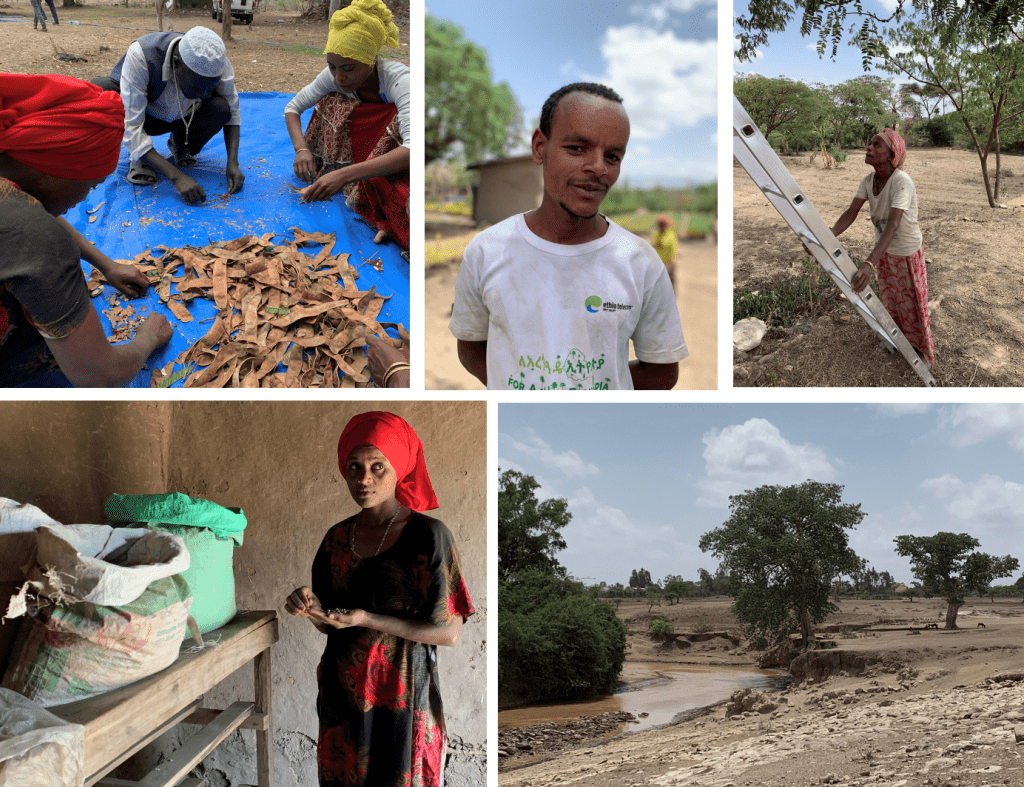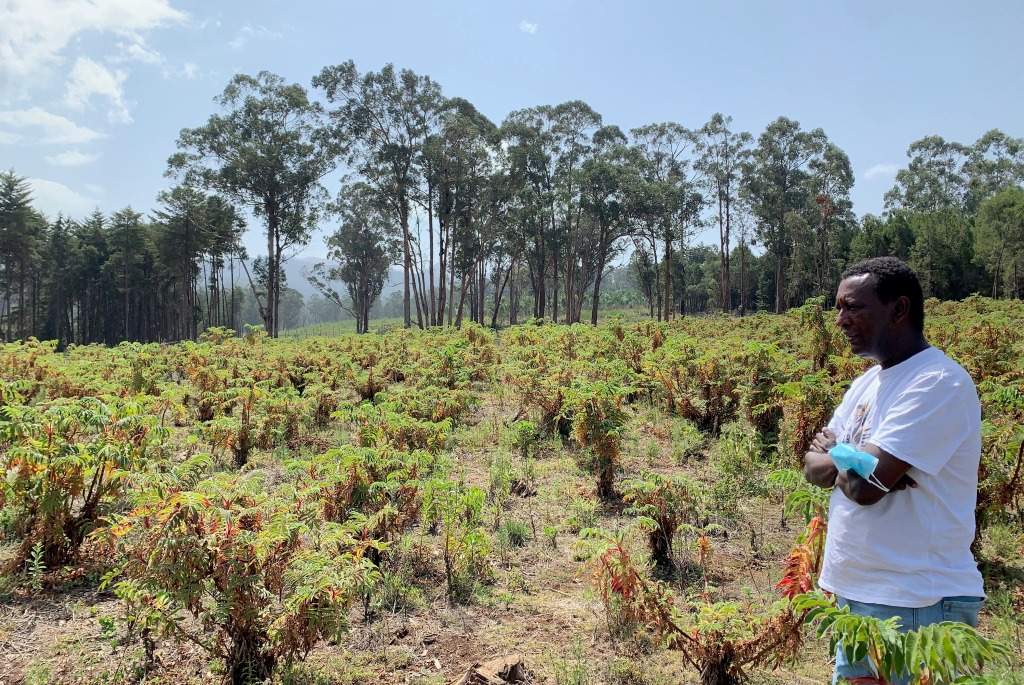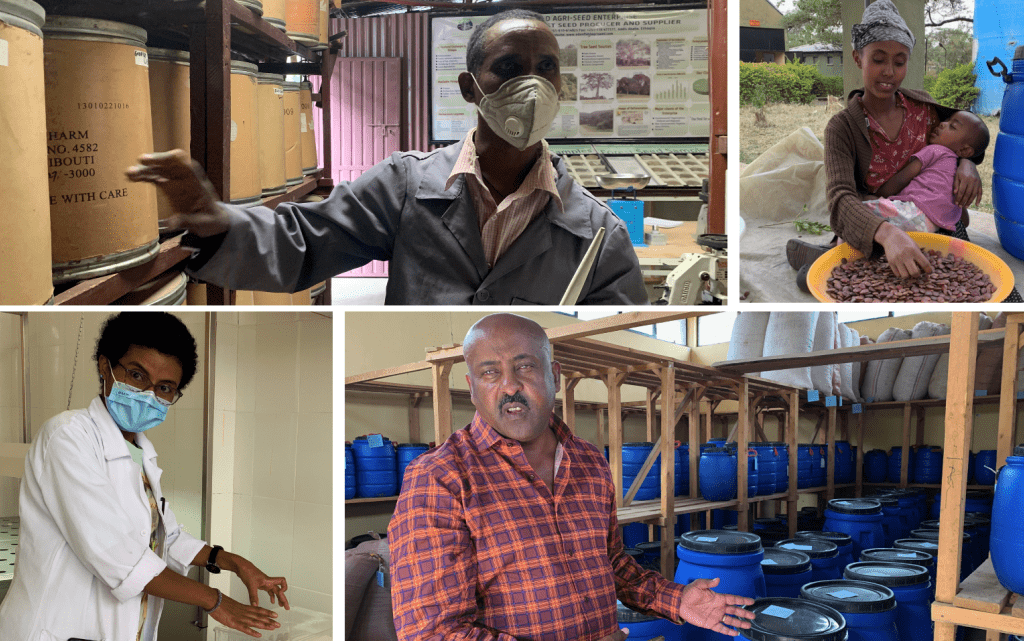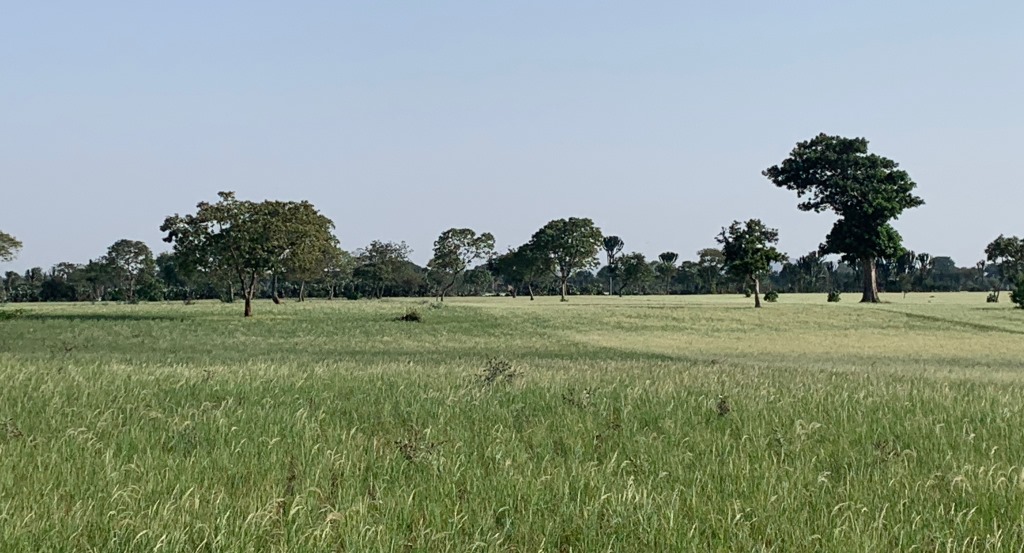
By Cathy Watson
Almost 300 kilometres south of Addis Ababa in Halaba zone, a young man hits branches of a tree with a bamboo pole. As seed pods rain on to a tarpaulin, women and an older man gather them for processing, and another youth high in the tree shakes down more.
Once back on the ground, the high tree climber, Shemssu Seman, 20, says, ‘Seed is a really good source of income. We used to buy it. But the germination rate was low, and when we collected for ourselves, we had a problem of tree selection: we took from whatever trees we found. Today we collect from many.’
The group has its own nursery and now sells the seed they collect and the seedlings that ensue. It is win-win. Both are of higher quality than what was available before, and thanks to a seed collection protocol, members are growing superior trees for themselves for timber, fruit, shade, soil and water conservation, fodder for livestock, and forage for bees. Bees particularly like the flowers of Cordia africana, says Shemssu. The tree also provides timber and mulch.
This tree is one of 15 that are the focus of an innovation called breeding seed orchards. The group are among 2400 rural people newly trained in the business of seed and how to collect for valuable traits like stem straightness for timber. And the tarp and ladder that helped Shemssu climb the tree are part of a drive to equip the seed sector.

All this activity emanates from a large Norway-funded project called PATSPO led by CIFOR-ICRAF with the Ethiopian government. It is likely the most comprehensive push to build a seed sector in any country. It speaks to CIFOR-ICRAFs goal of transforming the quality of tree growing.
‘The objective is to support government to meet tree seed demand. Ethiopia has huge commitment to the Bonn Challenge. Bringing 20 million hectares under restoration by 2030 requires a huge amount of seed,’ says PATSPO leader Soren Moestrup, one of a generation of Danish foresters who have dedicated their lives to tree seed at home and abroad.
The government is fully engaged and recognizes the gaps.
‘Ethiopia’s flora is well characterized. We have rich knowledge on species distribution and diversity. But still the great majority of seed is from unknown sources from informal sector seed suppliers and is of uncertain quality,’ says Abanyeh Derero, Director of Plantation and Agroforestry Research at Ethiopia Forest Development (EFD), the country’s new forestry body.
Describing the challenge further, Yigardu Mulatu, EFD’s Tree seed unit coordinator, says, ‘Currently each woreda (district) decides which species to produce, and seed procurement is done by finance officers. We are still highly dependent on exotics yet restoration should bring back native trees to their niches. We need science-led tree planting.’
The ‘Provision of Adequate Tree Seed Portfolio in Ethiopia’ project started in 2018 and aims to support the government to strengthen existing tree-seed organizations and private and government seed dealers. Among others, it works with, the Central Tree Seed Centre in Addis Ababa and four regional ones, Gullele Botanical Garden, universities, and the government-owned Oromia and Amhara Forestry Enterprises.
It is on the 3.7 million hectares of natural and planted forest land managed by Oromia Forestry Enterprise that some of the 30 breeding seed orchards (BSOs) developed by PATSPO sit.

Danish forester Erik Dahl Kjaer, one of the originators of the BSO concept, defines a BSO as serving ‘multiple purposes’, producing seed, testing genetic entries (progeny trial), and providing a breeding population by establishing a seed orchard based on progenies from selected trees in a repeated block design’.
In simpler language, BSOs are created from seed collected from the best mother trees across areas where a species occurs; 2500 trees are planted per hectare, and 1-3 hectares per species. These are gradually thinned leaving an orchard that is a source of high quality and improved seed. Each tree has a bar code detailing where it originates from.
Gesturing to an orchard of East African Pencil Cedar (Juniperus procera), PATSPO project leader Abrham Abiyu explains that seed had been taken from 22-25 trees in each of six locations: Suba/Menegesha, Wof Washa, Dodola, Yegof-Wollo and Tigray.
‘This species is very important socially, ecologically and economically. It is termite resistant and very in demand for tools, houses, hedges, fences, woodlots and large-scale plantations. And people like the smoke.’
There are orchards as well of Grevillea robusta and Eucalyptus globulus. Of the latter, Abiyu says, ‘You can see why people plant them. It’s a cash crop that can be coppiced five times.’ The breeding objective for Cordia africana is a ‘branching habit’ of fewer branches.
‘The main thing for a BSO is that seed should be collected from 20 plus mother trees and spaced some distance apart,’ he says. ‘BSOs enable us not to wait long for elite planting materials. If we followed traditional tree breeding, it would take much longer,’ he says.

At the Amhara Forestry Enterprise in the city of Bahir Dar, Director General Biadglign Shiferaw said PATSPO had had a ‘right hand role’ in 2021 in helping them: describe and document more than 60 seed sources; set up 14 breeding seed orchards; and train 58 groups that collected 33,500 kg of seeds, earning on average $1206 each.
‘These BSOs will produce a huge amount of seed from a small plot of land,’ said the forester. ‘Without seed sources, there is no forest development. And if there is no forest development, there is no forest industry. ‘
Across the project more than 200 seed sources have been documented and described, and BSOs of 15 species assembled. Eight species are indigenous: Cordia africana, Albizia gummifera, Hagenia abyssinica, Juniperus procera, Podocarpus falcata, Olea europaea ssp. cuspidata, Moringa stenopetala and Faidherbia albida. Seven are exotic: Grevillea robusta, Eucalyptus grandis and globulus, Cupressus lusitanica, Acacia decurrens, Pinus patula and Casuarina equisetifolia.

Species for future BSOs include Prunus Africana, Boswellia sacra, the primary tree that produces frankincense, and Millettia ferruginea, which is endemic in Ethiopia. Separate activities are on-going for indigenous fruit trees such as Adansonia digitata (baobab) and Ziziphus mauritiana.
A PATSPO survey deduced that just 20 species constitute 99% of trees currently planted in Ethiopia, and Eucalyptus species account for 90%. There is a need for greater representation of some of Ethiopia’s 1200 trees.
‘This is a new model. We can recommend it. We are successful with promising results,’ says Abiyu.
‘We wish more people thought about tree seed,’ says Amhara Forest Enterprise DG Shiferaw.
PATSPO is funded by the Norwegian International Climate and Forest Initiative (NICFI) through the Royal Norwegian Embassy in Ethiopia (RNE). World Agroforestry (ICRAF) is responsible for the implementation of the project, in coordination with the Ethiopian Forestry Development. A second four-year project commenced in May 2022.

















